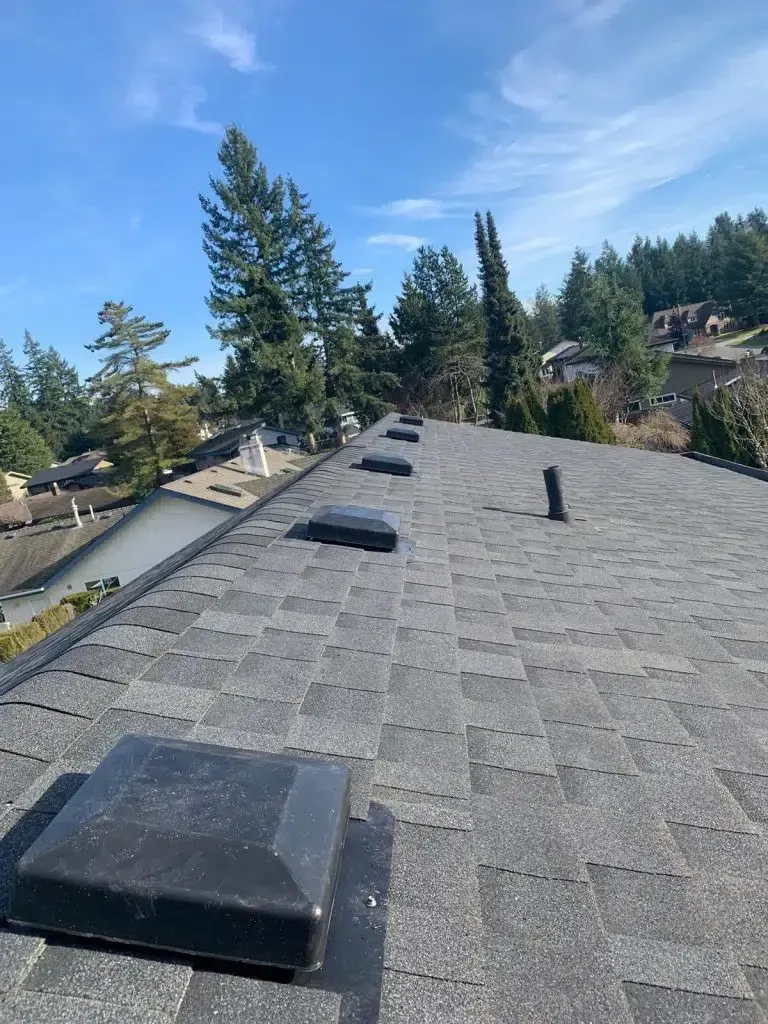Preparing Surrey Roofs for Wind & Rain
Preparing Surrey Roofs for Wind & Rain
Preparing Surrey Roofs for Wind & Rain means inspecting, tightening, and waterproofing every roof layer before coastal storms arrive.
- Inspect shingles; replace all loose pieces.
- Secure flashing at vents and chimneys.
- Unclog gutters; fit debris guards.
- Upgrade fasteners to hurricane-rated screws.
- Book annual professional maintenance.
| Factor | Value | Note |
|---|---|---|
| Average winter winds | 60 km/h gusts | Pacific frontal systems |
| Peak rainfall month | November – 198 mm | Atmospheric rivers |
| Recommended shingle rating | ASTM D7158 Class H | Withstands 209 km/h |
Foreword: Sky-Watched Wisdom from South Fraser’s Ridge
I’m Harman, lead installer at Paragon Roofing BC, and I’ve paced more Surrey ridgelines than I’ve driven the Fraser Highway. The moment cedars begin flexing eastward and the air smells like salt-slick asphalt, I know the rainy gales are rehearsing their yearly opera. What follows is a 2,000-word, pulse-quickening dive—equal parts shop-talk and storm-lore—into bulletproofing your Surrey roof before the clouds unload.
1. Surrey’s Storm Signature—Why “Normal” Doesn’t Apply
Surrey isn’t merely “rain-prone.” It straddles Pacific and inland weather systems, funneling jet-stream energy through Boundary Bay, where cold outflow meets ocean-warmed air. Result: pressure gradients that hurl 70 km/h gusts at unprepared eaves. Combine that with a median of 1,430 mm annual rainfall—much of it squeezed into four wild months—and you have a meteorological blender. Coastal cedar shakes swell, asphalt shingles curl, metal seams sing with galvanic fretwork. A roof here must behave like a ship’s deck—flexible yet watertight, anchored yet breathing.
Microclimate Pockets
- Cloverdale Plateau: Sudden shear winds from valley venturi effects.
- South Surrey Peninsula: Salty mist accelerates fastener corrosion.
- Guildford High-Rise Shadow: Turbulence amplified by urban canyons.
Understanding these pockets matters because a fix that works in Newton may fail on Ocean Park’s bluffs.
2. Anatomy of a Surrey Roof Failure
Before prescribing solutions, dissect the enemy:
| Failure Mode | Trigger | Domino Effect |
|---|---|---|
| Shingle uplift | 50 km/h side gust | Exposes felt, wicks rain under sheathing |
| Flashing peel | Galvanic corrosion | Opens 3 mm gaps—enough for capillary action |
| Gutter overflow | Needle-clogged downspout | Water backs under starter course |
| Soffit suction | Pressure differential | Drives rain horizontally into attic |
| Deck rot | Persistent humidity | Compromises fastener bite strength |
Each failure is a storyteller whispering, “You skipped one tiny step last fall.”
3. Autumn Prep Timeline—What to Do and When
| Month | Action | Tool Kit | Remark |
|---|---|---|---|
| September | Drone or binocular inspection | 4K drone, chalk | Document baseline condition |
| Early October | Tighten cap nails | 2″ ring-shank nails | Replace every proud nail |
| Mid-October | Flashing reseal | 100 % silicone, kick-out plates | Target chimney saddles |
| Late October | Clean & guard gutters | Leaf filter mesh | Prevent maple spore sludge |
| November 1-7 | Attic moisture audit | Hygrometer | Keep ≤ 14 % wood moisture |
Miss one checkpoint and the calendar will remind you with a leak.
4. Material Alchemy—Mixing Strength and Flexibility
Shingles:
Prefer Class H fiberglass asphalt with polymer-modified asphalt (SBS) for extra pliability in freeze-thaw.
Underlayment:
Double-lap self-adhered ice-and-water membrane along all eaves, plus a synthetic breathable sheet mid-roof.
Fasteners:
Stainless ring-shank nails for cedar; #10 hex-washers for metal panels, EPDM-backed.
Sealants:
Neutral-cure silicone at temperature range –20 °C to +50 °C; never latex.
Ventilation:
Ridge vent continuous 60 in² NFA per 100 ft² attic; pair with soffit intake to keep dew point outside the insulation line.
These ingredients transform a vulnerable roof into a pressure-equalized shield. For deeper insight, explore our storm-resistant roofing Surrey solutions.
5. Wind Physics on the Ridge—Why Gusts Lift Up, Not Sideways
It’s tempting to imagine wind ripping shingles sideways. In reality, Bernoulli pressure creates uplift. When gusts rush over the ridge, velocity spikes, static pressure drops, and like airplane wings, shingles try to fly. Class H shingles counter with heavier mats and six-nail patterns; metal panels rely on concealed clips spaced 12″, each clip bearing 250 lbf. Understanding pressure planes lets you nail, screw, and seal at exact stress points rather than “eyeballing.”
6. The Rain Factor—Vertical? Think Again
Surrey rain seldom falls politely vertical. Southerly squalls slant it 30°–45°, sneaking under laps. Capillary action needs only 0.1 mm gap to climb six inches inside an hour. Thus, step-flashing must overlap at least 3″ with bead-sealant interlock, and valley metal requires hemmed edges to disrupt crawl. Remember: water is an escape artist; design the maze.
7. Ventilation: Invisible Armor
An attic holding 20 °C interior air at 70 % RH collides with 5 °C outside fog—condensation festival. Water from inside rots sheathing faster than rainwater. Ensure:
- Continuous soffit intake —not decorative plug vents.
- Unblocked baffles —fiberglass batts often slump, choking airflow.
- Ridge vent continuity —stop cutting vent slot 1 ft short of hips; hot air parks there.
Proper airflow dries storm seepage before mold sets anchor.
8. Case Study—South Newton Rancher, 1978 Build
Problem:
Every November leak over bay window.
Diagnosis:
Outdated felt underlayment ended 2″ shy of fascia; gutter overflow reversed into fascia cavity.
Solution:
Installed ice-and-water membrane 6′ upslope, re-pitched gutters ¼″ per 10′, swapped 2″ spikes for 3″ hidden hangers.
Outcome:
Last winter’s 184 mm monthly rainfall—dry drywall, zero call-backs.
Moral: details compound.
9. DIY vs Pro—Knowing When to Step Down the Ladder
- Tightening exposed nails? DIY with harness.
- Swapping blown-off tabs? DIY if under five missing.
- Resealing chimney flashing? Call a pro; masonry interfaces trap hidden voids.
- Full underlayment upgrade? Pro only—requires deck exposure, waste management, city permit.
Skill mismatches cost more than invoices.
10. Cost–Benefit Matrix
| Upgrade | Average Cost (1,500 ft²) | Storm-Related Savings (10 yrs) |
|---|---|---|
| Class H shingle re-nail | $750 | $2,300 leak avoidance |
| Gutter guard install | $1,100 | $1,600 fascia repairs |
| Full ice-shield eaves | $2,800 | $5,200 interior damage |
| Continuous ridge-soffit vent | $1,400 | $900 energy, $900 mold |
Return on weatherproofing dwarfs sticker shock.
11. Five Rookie Mistakes We Still See
- Nailing through self-adhered underlayment —voids warranty instantly.
- Installing ridge vent without soffit intake —creates negative pressure, sucks rain.
- Leaving old metal valley beneath new shingles —galvanic



